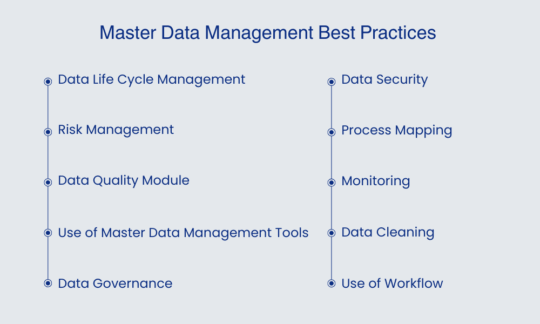One of the substantial challenges for a company is to create a single vision of the truth for corporate data, maintaining its quality, accuracy & reliability.
Master data management can be your advantage when it comes to streamlining data management.
In this article, we’ll cover why master data management is important and some critical best practices that every business should consider.
Master data is the central data in an organization that determines the domains involved in managing a business.
This data is hardly altered and can incorporate reference data, which can correlate to information outside the domain of corporate data and is crucial for business administration.
MDM encompasses a set of methodologies, processes, architectural solutions, and software.
Together, they help business managers understand and manage their master data characteristics, ensuring consistency, control in maintenance, and conditions of use of this data.
It is used in several processes that permeate different business areas of a company and are considered extremely important for its existence.
The need for MDM arises when companies begin to understand the losses resulting from poor quality and also from the high degree of data redundancy in their databases.
However, as we know, most companies neglect the architectural issue, building proprietary bases at different times, by different teams, with disparate concepts, storing data with different rules and unequal quality standards.
Master data management framework brings the possibility of matching, consolidating, and unifying the company's main master data concepts.
It streamlines business data by clustering data with multiple formats from various data sources and formulating an integrated view, eradicating data silos. This prompts to fewer errors and less redundancy, incorporating the methods.
Also Discover: Data loss prevention techniques: You should follow.
Data Life Cycle Management: The data lifecycle management process area contains practices that support a company to make sure that its data flows are well mapped to business processes at all life cycle stages.
Risk Management: Risk management is one of the best practices for master data management that supports the organization in identifying and analyzing potential problems. When carrying out this analysis, the organization must plan and execute appropriate actions, ensuring that the data management program's objectives are achieved.
Data Quality Module: Data quality strategy describes practices that aim to support the organization to develop, define and approve an integrated plan that mainly ensures that the quality of the data is sufficient to meet the needs defined for the business.
Use of Master Data Management Tools: It is challenging to preserve and manage the data, so it is recommended to use core management tools in your master data management strategy. In addition, ensure
Data Governance: A data governance framework must be very operational and have senior management sponsorship. This system enables the company to avoid significant deviations in its key indicators. Such a structure makes it possible to set up a common quality database on which the whole company relies.
Data Security: Do not install any unnecessary components. By forgoing software and features that you don't need, you limit the opportunities for hackers to exploit your server. Be sure to regularly update and monitor your tools and applications by immediately applying security fixes before it is too late.
Process Mapping: The mapping process is very useful to regulate the work and identify possibilities for improvement in an organization's business processes. It helps organizations to be more efficient and competitive. Knowing the flow of data through processes helps you better visualize how data is being used.
Monitoring: It is crucial to compute the results of your data management strategy, as it is one of the critical success factors for MDM. Based on the results, you make changes to your strategy as it facilitates decision-making.
Data Cleaning: The data cleaning process must support the organization to achieve efficiency in data management, where these activities must reduce effort and decrease storage or processing costs.
Use of Workflow: Having a robust workflow process is another best practice for master data management that will give you more flexibility to establish your plans in workflows. It can be used to examine master data redundancy and accuracy.
Concluding Words
After going through this article, you must have known the needs related to the business when it comes to master data management.
You need accurate and consistent data to contrast your business. By using MDM, you can efficiently maintain data from various sources.
With MDM, it is possible to apply a unique option to manage each step of the entire process. In this way, organizations obtain an opportunity to reduce time to market, manage data more efficiently, as it flows through the organization and through external channels.
You may also like to Read:
File Integrity Monitoring Best Practices: You Need to Implement





